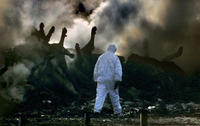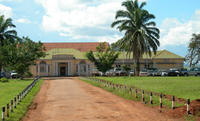-
UN peacekeepers to blame for Haiti cholera, report says
A scientific report prepared for the Haitian and French governments says that Nepalese soldiers — members of the UN peace keeping contingent in Haiti — are the likely source of the cholera epidemic which so far has killed 2,120 people and required medical treatment for 100,000 more; the study found that the source of the outbreak was a Nepalese peacekeeping base, whose toilets contaminated the Artibonite river; the river was the main focus of the outbreak when it began in October, but cholera has since spread throughout the country
-
-
Capitalism to strengthen U.S. response capability to epidemics, bioterrorism
The H1N1 flu pandemic highlighted critical gaps in the response capability of the United States, among them: the United States relies almost entirely on foreign suppliers for influenza vaccines and, perhaps as important, production of vaccines for a novel disease strain can take as long as six months; the U.S. Department of Health and Human Services (HHS) wants to reinvent the U.S. medical countermeasures enterprise, from new doctrines for regulatory approvals to nimble, domestic manufacturing capability developed in partnership with the private sector
-
-
Underground "physical Internet" to distribute food, goods
A start-up proposes automatically routed canisters to replace lorries for the purpose of delivering food and other goods in all weather with massive energy savings; the proposal envisions putting goods in metal capsules 2-meter long, which are shifted through underground polyethylene tubes at speeds of up to 60 miles per hour, directed by linear induction motors and routed by intelligent software to their destinations
-
-
Increasing cooperation between security, health officials
Those in charge of preventing and treating man-made diseases (bioterrorism) and those in charge of preventing and treating naturally occurring epidemics have increased cooperation because of a growing recognition by both sides that only way to monitor the rapidly increasing globalization of “dual-use” biological technology — which can be used in regular research efforts or clandestinely put toward a weapons program — is to pool their resources
-
-
Senate passes sweeping food safety bill
The Senate passed legislation Tuesday to make food safer in the wake of deadly E. coli and salmonella outbreaks, potentially giving the government broad new powers to increase inspections of food processing facilities and force companies to recall tainted food; the $1.4 billion bill, which would also place stricter standards on imported foods, passed the Senate 73-25
-
-
More questions raised about security of Boston BioLab
Boston University has opened a $178 million biolab in a residential area in Boston’s South End; the facility, in which lethal diseases such as Ebola and the plague will be studies, houses only administrative staff, pending state approval; that approval depends on a final risk assessment review — but a new study by the National Research Council questioned the methodology of ongoing risk assessment by contractor Tetra Tech
-
-
MS drug to lead fight against bioterrorism
A drug already approved for treating multiple sclerosis show promise as a long sought treatment for victims of bioterrorist attack with botulinum neurotoxin — which is 10,000 times deadlier than cyanide and the most poisonous substance known to man
-
-
Northrop Grumman testing autonomous biodetection instruments for BioWatch
DHS has awarded Northrop Grumman a contract to begin field testing a new generation of autonomous biodetection instruments as part of the BioWatch Gen-3 program.; the total potential value of the contract is $37 million over three years
-
-
Report: DHS underestimates risks of accidental pathogen release at Kansas BioLab
Manhattan, Kansas, is the proposed location of a new, $450 million BioLab44 DHS research facility; a National Academy of Sciences panel report says that a risk assessment by DHS of the new facility vastly underestimates the risk of an accidental pathogen release from the lab and the associated costs; the NAS report also said last month’s analysis failed to learn from fifteen major accidental releases of the foot and mouth virus around the world
-
-
U.S. at bottom of health care survey of 11 rich countries
Americans are the most likely to go without health care because of the cost and to have trouble paying medical bills even when insured, a survey of eleven wealthy countries found; “We spend far more on health care than any of these countries, but this study highlights pervasive gaps in U.S. health insurance that put families’ health and budgets at risk,” said Cathy Schoen, the lead author of the study
-
-
Bandages changes color to indicate state of a wound
Medical dressings are effective at protecting the site of an injury, but to examine a wound they must be removed; this can not only be painful for a patient, but it can also allow germs to enter the wound and cause infection; researchers developed dressing materials and plasters that do not need to be removed to check the state of a wound — they indicate pathological changes in the skin by changing from yellow to purple
-
-
Safety of planned Kansas Biosafety-Level 4 lab questioned

A new National Research Council report finds “several major shortcomings” in a DHS assessment of risks associated with operating the proposed National Bio- and Agro-Defense Facility (NBAF) in Manhattan, Kansas; one example: the report says there is nearly a 70 percent chance over the 50-year lifetime of the facility that a release of foot-and-mouth disease could result in an infection outside the laboratory, impacting the economy by estimates of $9 billion to $50 billion; roughly 9.5 percent of the U.S. cattle inventory lies within a 200-mile radius of the facility; another concern of the committee was the lack of an early-release detection and response system, clinical isolation facilities, and world-class infectious disease clinicians experienced in diagnosing and treating laboratory staff or communities exposed to dangerous pathogens that affect people
-
-
Cholera to linger in Haiti for years to come
Worldwide, poor sanitation that spreads cholera and other gut infections accounts for 2.4 million deaths a year, and 6.6 per cent of all life-years lost to disease and disability; the current cholera crisis in Haiti offers a grim example: cholera deaths are climbing sharply in Haiti, after the infection reached the capital, Port-au-Prince, as feared; epidemiologists who have studied other outbreaks predict that hundreds of thousands of Haitians will be stricken by the infection over the next few years as cholera takes hold in the country
-
-
U.S. sees East Africa as front line in bioterrorism war

Africa emerges as the front line in the war against bioterrorism; anthrax killed hundreds of hippopotamuses in Uganda in recent years; in 2008 a Dutch tourist died from Marburg disease after visiting a cave in a national park; in 2007 an Ebola outbreak killed more than twenty people; American officials say that the underlying threat is that lax security at the poorly financed labs that collect and study these and other deadly diseases pose a bioterrorism risk; the rise of Islamist radicals in several countries in East Africa has refocused attention on this region as a frontier in American security interests
-
-
Detecting use of abnormal organisms as bioterror weapons
Organisms have the potential to cause disease, but they can be altered to cause an unrecognized diseases or a process a process that doctors have not associated with that organism; this makes altered forms of bacteria like salmonella or E. coli the potential “bombs” in a bio-terrorist attack, but scientists at Purdue University developed a new way to look at those bacteria; now, West Virginia University is testing its potential
-
More headlines
The long view
A Shining Star in a Contentious Legacy: Could Marty Makary Be the Saving Grace of a Divisive Presidency?
While much of the Trump administration has sparked controversy, the FDA’s consumer-first reforms may be remembered as its brightest legacy. From AI-driven drug reviews to bans on artificial dyes, the FDA’s agenda resonates with the public in ways few Trump-era policies have.
